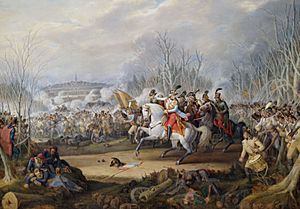Battle of Biberach (1796) facts for kids
Quick facts for kids Battle of Biberach (1796) |
|||||||
|---|---|---|---|---|---|---|---|
| Part of the War of the First Coalition | |||||||
 Battle of Biberach by Johann Baptist Pflug |
|||||||
|
|||||||
| Belligerents | |||||||
| Commanders and leaders | |||||||
| Strength | |||||||
| 35,000 | 15,000 | ||||||
| Casualties and losses | |||||||
| 500 killed and wounded | 300 killed and wounded, 4,000 captured, 18 guns captured | ||||||
The Battle of Biberach was an important fight during the French Revolutionary Wars. It happened on October 2, 1796, near Biberach an der Riss in Germany. In this battle, the French army, led by General Jean Victor Marie Moreau, fought against the Austrian army, led by Maximilian Anton Karl, Count Baillet de Latour.
The French army was retreating towards the Rhine River. The Austrian army was chasing them. But the French decided to stop and fight back. They wanted to hit the Austrians hard. The battle was a victory for the French.
Contents
Why the Battle Happened
During the summer of 1796, two French armies were moving into southern Germany. General Jean-Baptiste Jourdan led one army in the north. General Moreau led the other in the south. They were fighting against two Austrian armies. These were led by Archduke Charles, Duke of Teschen and Count Latour.
Archduke Charles and another general, Wilhelm von Wartensleben, joined forces. They attacked Jourdan's army and defeated it. This left Moreau's army alone. After Jourdan lost another battle, Moreau had to retreat. He needed to avoid being cut off from France.
As Moreau's army retreated, Count Latour's Austrian army followed them closely. Latour's army was smaller than Moreau's. Moreau decided to turn around and attack Latour near Biberach.
The Battle Begins
The battle started around noon on October 2. French troops, led by General Louis Desaix, attacked first. They moved through areas like Seekirch and Ahlen. They pushed back the Austrian soldiers they found there.
On one side of the battle, the French attacked the Austrian general Siegfried Kospoth. This forced Kospoth's troops to fall back. They retreated through Biberach to a place called Galgenberg.
Meanwhile, other French groups attacked different parts of the Austrian army. They pushed back Austrian divisions led by General Mercandin and Prince de Conde.
French Push Forward
A French group led by Claude Saint-Cyr made a smart move. They went through a difficult, swampy area that the Austrians thought was impossible to cross. This allowed them to attack Latour's army from the side.
With attacks from different directions, Latour had to pull his main forces back. The Austrian divisions under Prince Conde and Mercandin were pushed back even further.
General Desaix found a way to go around the Austrian lines. He moved his troops through a valley towards Biberach. This made Latour realize he had to order a full retreat.
Austrian Retreat
The Austrian generals Mercandin and Prince Conde had to retreat to different towns. Kospoth's division went through Biberach. The French quickly advanced. They captured the city's defenders and the last few Austrian battalions.
During the retreat, some areas like Appendorf were set on fire. The fighting continued into the night in some places.
The Austrian army under Baillet-Latour was defeated. They lost about 300 soldiers who were killed or wounded. They also lost 18 cannons and two regimental flags. The French lost about 500 soldiers. But they captured 4,000 Austrian prisoners.
After the Battle
After their victory, the French army continued its retreat. General Desaix's troops followed the Danube River. General Saint-Cyr's troops took a different route. A small group of French soldiers stayed behind to watch the defeated Austrians.
The Austrians, after this loss, decided to keep their distance. They followed the French but did not try to stop them again right away. The fighting started up again later in the Battle of Emmendingen on October 19. After another battle, the Battle of Schliengen on October 24, Moreau's troops finally crossed the Rhine River to safety.

